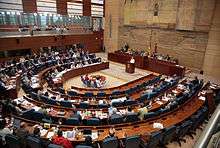Assembly of Madrid
| Assembly of Madrid Asamblea de Madrid | |
|---|---|
.svg.png) | |
| Type | |
| Type | |
| Houses | Unicameral |
| Leadership | |
|
María Paloma Adrados Gautier, PP | |
| Structure | |
| Seats | 129 |
 | |
Political groups |
Government (48)
Supported by (17)
Opposition (64) |
| Elections | |
Last election | May 24, 2015[1] |
Next election | 2019 |
| Meeting place | |
 | |
|
Chamber of the Madrid Assembly Plaza de la Asamblea, Madrid, Community of Madrid | |
| Website | |
| www.asambleamadrid.es | |
Coordinates: 40°22′55.15″N 3°39′44.29″W / 40.3819861°N 3.6623028°W The Assembly of Madrid or Madrid Assembly (English: Asamblea de Madrid) is the unicameral regional legislature of the Autonomous Community of Madrid since the approval of the Madrid Charter of Autonomy in 1983.
It is elected every four years during the Spanish Regional and Municipal elections, as the Community of Madrid Charter of Autonomy does not recognise the right to call early elections (as in the Basque Country, Catalonia, Galicia and Andalusia), save for exceptional situations like the scandal that deadlocked the May 2003 Assembly and forced fresh elections in October 2003. According to the Charter, the Assembly is empowered to draw the Madrid Regional legislation, to control the Regional Government's actions and to elect the President of the Community of Madrid.
The Assembly meets in the district of Vallecas of Madrid in a hall inaugurated in 1998 specifically designed to host the Madrid Assembly.
Membership
The legislature is currently (as of 2015) made up of 129 deputies,[1] elected all at once in closed party lists for terms of 4 years. Seats are allocated using the proportional D'Hondt method in one constituency, which makes the Madrid Assembly one of the biggest parliaments in the world with one only constituency. In 2007, this fact moved President Esperanza Aguirre to propose splitting the Community of Madrid into twelve constituencies[2] of 9 to 15 AMs each. The alleged benefit was increasing the contact between statesmen and their electors, but the reform was rejected by the rest of parties in the Assembly on the grounds that it was not a pressing matter, and it would alter the composition of the assembly in favour of the most voted party. Eventually, the proposal was abandoned even though President Aguirre had the majority to pass it through the Assembly, because it would be defeated in the Cortes Generales as it had to be done through a process of reform of the Charter of Autonomy.
Parties that obtain more than 5AMs can form a parliamentary group, in order to organise and participate in the debates and committees of the assembly. Parties that do not reach that number of seats will be part of the mixed group. Currently the threshold for obtaining seats in the Madrid Assembly is 5% of the total votes cast including votes "en blanco" i.e. for "none of the above", thus making it mathematically impossible for a party to obtain less than five seats.
Leadership
The Madrid Assembly's Leadership resides in the Bureau of the Assembly comprising a President (Speaker), three Vice Presidents who chair debate when the President is absent, and three Secretaries, elected in the first session of each newly elected Assembly. The Bureau is tasked with managing the Assembly schedule and interpreting its rules of order, including the power to expel members from the sessions.
| Position | Name | Party |
|---|---|---|
| President (Speaker) | The Most Excellent María Paloma Adrados Gautier | PP |
| 1st Vice President | The Honble. Juan Trinidad Martos | Ciudadanos |
| 2nd Vice President | The Honble. Modesto Nolla Estrada | PSM-PSOE |
| 3rd Vice President | The Honble. Laura Díaz Román | Podemos |
| 1st Secretary | The Honble. Rosalía Gonzalo López | PP |
| 2nd Secretary | The Honble. María Carmen López Ruiz | PSM-PSOE |
| 3rd Secretary | The Honble. Juan Antonio Gómez-Angulo Rodríguez | PP |
There is also a second, consultative body, the Spokespersons' Council (Spanish: Junta de Portavoces), which is made up of the leaders and spokespersons from each parliamentary group[3] in the Assembly and has the right to be "heard"[4] before the Bureau takes some decisions such as scheduling debates and votes. In the Spanish system, however, ruling parties usually do not hold a tight grip over the Parliament's schedule, nor do they use it to turn down the opposition proposals without debate: they are just voted down in committee or by the full house after the shortest debate allowed by the rules of order. Thus, while control of the Bureau and the Spokespersons' Council is definitely important, it is not a critical matter as it sometimes becomes in other systems.
Committees
The Assembly organises its work in different committees. Committees are constituted by the bureau of the Assembly on the advice of the Spokespersons' Council. The number and grouping of its members is also determined at the same time. The election of the membership of the committees is a role of the parliamentary groups that have to be always represented in the committees. The committees are directed by a Bureau composed of a Chair, a vice-chair and a secretary and each group is to designate a Spokesperson and an adjutant spokesperson for the committee, that will usually take care of that matters also in the plenary.
See also
References
- 1 2 Madrid election results (Spanish) Historiaelectoral.com, accessed 26 November 2012
- ↑ "El Ejecutivo de Aguirre insiste en dividir la región en 12 circunscripciones electorales, frente a la única actual" (in Spanish). El País. 2007-06-15. Retrieved 2007-06-15.
- ↑ Each representative's vote counts as the full power of his/her parliamentary group, so the majority of the ruling party or coalition can't be overturned by a more numerous (in terms of parliamentary groups) opposition.
- ↑ Literally, in the Spanish legal jargon, some decisions are to be taken "oída la Junta de Portavoces", that is, "having heard the Spokespersons' Council's opinion".
External links
- Official site of the Madrid Assembly - In Spanish by default, also has an English version